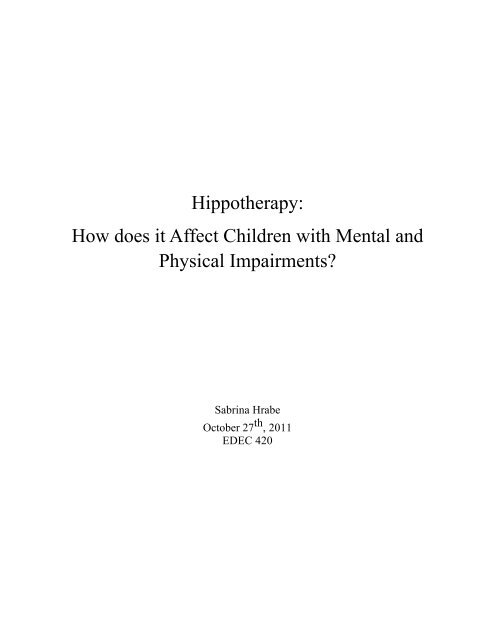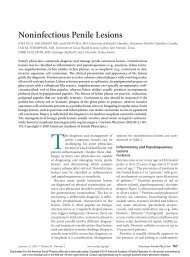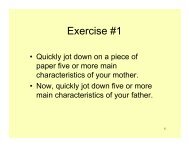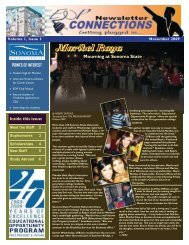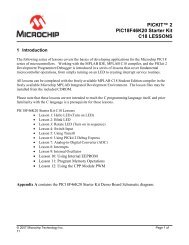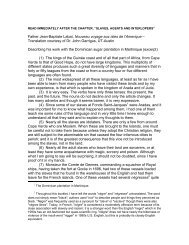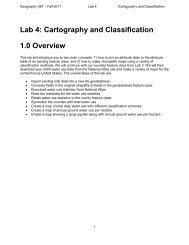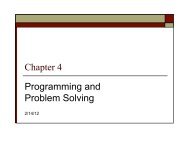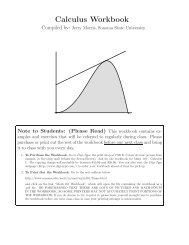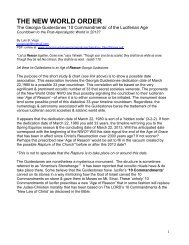Hippotherapy - Sonoma State University
Hippotherapy - Sonoma State University
Hippotherapy - Sonoma State University
Create successful ePaper yourself
Turn your PDF publications into a flip-book with our unique Google optimized e-Paper software.
<strong>Hippotherapy</strong>:<br />
How does it Affect Children with Mental and<br />
Physical Impairments?<br />
Sabrina Hrabe<br />
October 27 th , 2011<br />
EDEC 420
Introduction<br />
Her legs involuntarily cross at her shins. Her feet and toes curl as her shoes come off. Her<br />
arms contract as if stuck in imaginary elbow casts. Yet, sixteen year old Jazzy still waits patiently<br />
in her wheelchair as I fasten her shimmery, metallic blue helmet. While her care giver pushes her<br />
up the ramp to the mounting block, I sneak a quick glimpse of what could be a smile as she<br />
anticipates Stormy’s arrival. Jazzy suffers from spastic cerebral palsy, and for the past thirteen<br />
years, has received hippotherapy treatment with the infallible Stormy—an 1100 pound black<br />
Missouri Fox-Trotter.<br />
Horses have long been known as the “helper and healer of humans” (Meregillano). It dates<br />
back to the 5th century to the days of Hippocrates. He was the first to propose the healing power of<br />
horses and described it as “a universal exercise with a ‘healing rhythm’” (Granados). Even though<br />
the horse has been represented as a “healer” for several centuries, the use of horses in a therapeutic<br />
setting did not emerge in the United <strong>State</strong>s until recent decades (Lane). It was not until the 1970’s<br />
that physical therapists in the U.S. started using horses for treatment, and finally, in 1987 an actual<br />
program was established (Benjamin). This form of therapy is known as hippotherapy: “treatment<br />
with the help of the horse” (Meregillano). This paper will focus on the effects of this modern<br />
therapy in children with mental and physical impairments. It will present studies that will provide a<br />
better insight into the recent success of hippotherapy.<br />
Discussion of Research
Today, hippotherapy is being used on a global scale with 650 centers in the United <strong>State</strong>s to<br />
treat children with an array of disabilities (Lane). Through every rhythmic stride the 1100 pound<br />
animal takes, the horse proves its medicinal benefits in more ways than one. <strong>Hippotherapy</strong> has<br />
shown improvements in every area of physical functions such as balance, coordination, strength,<br />
and posture. However, the physical advantages aren’t the only benefit children reap. Emotional,<br />
social, and cognitive improvements have also been observed with increased self-esteem,<br />
confidence, and communication. It “is multifaceted and has extraordinary effects on all body<br />
systems” (Meregillano).<br />
Many may confuse hippotherapy with therapeutic riding; although, these two concepts<br />
differ greatly. Unlike therapeutic riding, hippotherapy focuses on skills to improve the patients<br />
sensory processing and neuro-motor functions in daily life rather than teaching horsemanship skills<br />
(Meregillano). Therapeutic riding takes a group of people that may or may not have physical or<br />
mental disabilities and takes a more adaptive approach. However, the biggest distinction between<br />
the two is that therapeutic riding doesn’t require a medical professional. <strong>Hippotherapy</strong>, on the other<br />
hand, must have a certified physical, occupational, or speech therapist that specializes in this field to<br />
run treatment sessions. The therapist must exhibit knowledge of the horse’s movement, responses,<br />
and attitude to gain the best results as well as for the safety of patients. Horses used in<br />
hippotherapy are simply the tools to achieve success while the patient rides passively.<br />
Sitting astride a horse engages just about every muscle group in the body. The passive<br />
riding style of modern hippotherapy requires the horse to move the rider, which promotes its many<br />
advantages (Granados). The environment of hippotherapy activates each one of the child’s senses.
It allows for all kinds of sensory integration such as tactile, vestibular, visual, olfactory, and<br />
proprioceptive stimulation, as well as developing a stronger fine and gross motor system (Smith).<br />
Each minute astride a horse stimulates the child’s brain with up to 1,000 nerve impulses, which<br />
clearly can’t be duplicated in a clinical setting according to occupational therapist, Tricia Coates<br />
(Doucette). There are many different ways that therapists achieve the desired results. The sitting<br />
positions and exercises are designed for each child depending on their capabilities and/or<br />
disabilities. Different positions and activities on the horse encourage different sensory input. But<br />
the key element that separates hippotherapy from others is the rhythmic factor. While atop a horse,<br />
the rhythmic, swaying gait mimics that of the human walk (Benda). It essentially exercises the<br />
muscles used in gross motor functions, such as walking, without posing a struggle for the child as<br />
it may in a clinical setting. This is just one of the phenomena’s of hippotherapy treatment.<br />
Over the 40 years hippotherapy has been in practice, most of the research and studies have<br />
been done on children with cerebral palsy (Meregillano). This neurological disorder develops in the<br />
fetus or infant when there is damage to the central nervous system. Cerebral Palsy (CP) affects 1 to<br />
3 children for every 1000 live births (Benda). Because this disorder inhibits the proper<br />
development of the motor cortex, motor, postural, and cognitive abnormalities hinder these<br />
individuals their entire life (Zadnikar). CP differs in degrees of severity depending on how much<br />
and what part of the brain is damaged. <strong>Hippotherapy</strong> proves to be especially effective for these<br />
children because it “focuses on trunk stability, posture, and pelvic mobility impairments to improve<br />
gait and balance” (Meregillano).<br />
A meta-analysis was done in 2010 that looked at children with CP and the effects of
hippotherapy on their posture and balance. The final analysis includes eight studies and 173 total<br />
children ranging from 2 to 13 years of age. This group of children was split into an intervention<br />
group containing 84 children with CP and a comparison group with 89 children, 39 children with<br />
CP while the other 50 were non-disabled. The eight studies all had different types of hippotherapy<br />
sessions and duration. The intervention group received hippotherapy treatment, while the children<br />
with CP in the comparative group sat astride a barrel instead of a horse. Some sessions were 60<br />
minutes long and others as little as 8 minutes. These studies also varied from 12 week treatment<br />
sessions once or twice a week to just a single intervention. The results were measured either as a<br />
positive or negative outcome. Of the 84 children in the intervention group, 76 experienced a<br />
positive effect on their balance and posture with hippotherapy sessions. Only 21 in the comparison<br />
group had a positive outcome, and no positive or negative effects were found in the non-disabled<br />
children (Zadnikar). This analysis concludes that hippotherapy proves to be an effective form of<br />
treatment in children with CP.<br />
Yet, the validity of these studies remains weak due to the small sample size and<br />
reproducibility. Many different tests were performed in the hippotherapy sessions, so that is one<br />
factor which makes it difficult to conclude a generalized conclusion about the entire CP population.<br />
Another aspect that creates yet another grey area to conclude scientific evidence are the varying<br />
degrees and symptoms of CP. Because of this issue, it makes it extremely difficult to pinpoint<br />
specific causal relationships between hippotherapy treatment and CP, but we still shouldn’t deny<br />
the minimal, but obvious results.<br />
We can look at Jazzy’s situation, which exhibits apparent results of hippotherapy sessions.
When she first arrives in her wheel chair, her muscles are tight and contracted due to abnormally<br />
high muscle tone in her appendages. Three quarters of the session, Jazzy faces backward on her<br />
belly, so Fran Judd (Jazzy’s pt and owner of Renaissance Healing and Learning here in Cotati)<br />
and the side-walkers, can wobble and pull Jazzy’s arms and legs to stretch them straight out while<br />
the horse continues his rhythmic, energetic walk. The last part of the session, Fran drapes Jazzy<br />
over the horse’s back, which allows her muscles to relax and creates a whole body stretch. Jazzy<br />
also receives regular physical therapy, occupational therapy, and speech therapy along with<br />
hippotherapy. Yet, both Fran and her regular physical therapist agree that better results are<br />
observed after a hippotherapy session. Jazzy’s range of motion increases and it’s much easier to<br />
stretch Jazzy’s muscles out after a hippotherapy session than it is using regular physical therapy<br />
techniques (Personal communication October 16th, 2011). However, improved balance, muscle<br />
tone, and coordination are not the only beneficial sensory input Jazzy experiences. The effects of<br />
hippotherapy run deeper than what meets the eye.<br />
The emotional, social, and cognitive impacts of hippotherapy are as rewarding as the<br />
physical benefits. The scientific evidence of the psychological benefits of hippotherapy is even<br />
harder to discern from the physical benefits. But, “it’s been clinically proven that just being in the<br />
vicinity of horses changes our brainwave patterns” (Janakievska). Without even realizing it, this<br />
environment presents children with a range of stimuli for their brain to process. Therapists engage<br />
the child through various activities using songs, games, or anything that requires attentiveness and<br />
focus. By creating tasks to focus on, it almost forces the child to concentrate and process the<br />
information asked of them. A task as simple as giving the horse direction such as “walk” or<br />
“whoa” is an effective way of achieving communication skills (Smith). Children feel a sense of
pride, strength, or confidence being able to communicate and control such a large, powerful animal.<br />
This environment poses as a much more fun and less threatening learning atmosphere than a<br />
clinical setting, so children become more willing to learn (Smith). One possibility for this is the<br />
contact with an animal, especially a very large, majestic one.<br />
Horses give children a chance to connect emotionally and form a strong relationship. Many<br />
children with special needs seek those emotional ties, but have trouble forming them (Granodos).<br />
These animals accept people for who they are, without judgment, which special needs children long<br />
for, and many times humans can’t provide that. Children feel comfortable enough with the horse to<br />
share their deepest feelings (Granodos). However, the bond between horse and human isn’t the<br />
only strong relationship that forms. Since a hippotherapy session requires a minimum of three to<br />
four people (a therapist, one or two side-walkers, and a horse handler), it also lets children form<br />
strong emotional and social connections to the people around them. Each person present during a<br />
hippotherapy session acts as a tool to increase communication skills of the child. They engage the<br />
child in conversation, getting them to interact with others, which develops social and behavior<br />
skills that many lack. The presence of social interaction then links to cognitive function.<br />
Children with developmental disabilities have trouble focusing on the foreground. Their<br />
brain is more in tune with the background stimulus, which the child can’t necessarily control.<br />
<strong>Hippotherapy</strong> provides a way for children to channel their over active nervous system in a healthy<br />
manner. Horses are known to have a calming effect and children with developmental disabilities<br />
need that type of atmosphere to acquire better cognitive functions (Janakievska). Autism is the<br />
second most common developmental disability today with an average of 1 in 110 children suffering
in the United <strong>State</strong>s (Taylor and http://www.cdc.gov/ncbddd/autism/data.htm). Children with<br />
autism lack social and communication skills, have trouble with keeping attention, and may have<br />
problems with sensory integration (Bass). In 2007, a study found that 11% of parents chose<br />
hippotherapy for their autistic child (Taylor).<br />
In 2009, Renee Taylor of the <strong>University</strong> of Illinois published this study: “Volitional<br />
Change in Children with Autism: A Single-Case Design Study of the Impact of <strong>Hippotherapy</strong> on<br />
Motivation.” The Pediatric Volitional Questionnaire (PVQ) was used for this study and its way to<br />
measure a child’s motivation based on their environment. A child’s volition refers to their inner<br />
motivation, what interests them and what they find meaningful (Taylor). It was a 16 week<br />
hippotherapy program that looked at three autistic children ranging from four to six years old.<br />
Before each hippotherapy session, the children were videotaped and observed during standard play<br />
to establish a baseline and then observed again afterwards to determine if any changes in<br />
motivation occurred. The 45-minute hippotherapy was the same for each child and consisted of<br />
walking and trotting both directions around the arena, weaving through cones, and stepping over<br />
obstacles, such as ground poles. Posters were placed around the arena to stimulate their visual<br />
sense, and the therapist would reference these posters to try to get the children to respond, which<br />
activated language as well.<br />
The evaluation of these results was done with three PVQ tests, one at the beginning of the<br />
program, the second at the mid-point and the third at the end of the 16 weeks. The children were<br />
observed during standard play with an occupational therapist so their volition could be assessed<br />
without a bias approach. The results of the PVQ test determined that each of the three children
exhibited an increase in their motivation for everyday functions. <strong>Hippotherapy</strong> proves to be an<br />
effective form of treatment for changes in motivation for these autistic children. But, again, larger<br />
studies must be done to conclude stronger, scientific evidence.<br />
Fourteen year old Braden proves to be another success of hippotherapy. Fran Judd shared<br />
his story with me. Observing from afar, Braden appears to be pretty “normal” because he is<br />
described as having high-functioning autism. He has been coming to hippotherapy sessions with<br />
Fran for about three years now and has made immense progress. Fran described him to be tactilely<br />
defensive—meaning he is very hypersensitive to textures. When he first started coming for<br />
sessions, for example, Braden wouldn’t even pet the horse, sit on the sheepskin pad, or even break<br />
the wet carrot to feed the horse. Braden also is gravitationally insecure. It was not until recently that<br />
Fran was able to get him to face backwards on the horse, which was a huge accomplishment. It<br />
sounds so simple, but for autistic children their brain doesn’t process information in an orderly,<br />
logical manner. For a normally developed brain, we know we will be alright if we change our<br />
position in space or reach for something across mid-line, but these are the things Braden struggles<br />
with. But, over the years, Braden has become more willing, focused, and desensitized due to the<br />
variety of stimuli and textures in this natural environment. He is another success of hippotherapy.<br />
Basically, the children suffering from developmental disabilities lack stimulation to control<br />
their unorganized nervous system. Consequently, in order to compensate for this, they might<br />
misbehave or act out because they are trying to find some way to have that organization.<br />
<strong>Hippotherapy</strong> helps do that by providing deep sensory input, and one factor that plays a part in that<br />
is the repetitive movement of the horse and the three dimensional atmosphere. Braden, along with
many other children, are just seeking stimulation that their nervous system craves (Personal<br />
communication October 16th, 2011).<br />
Conclusion<br />
However beneficial this modern treatment may seem, it still lacks the scientific evidence.<br />
The limited studies done thus far prove to be making stride since all seem to support hippotherapy<br />
treatment. Larger, broader studies need to be conducted before proposing a definite scientific<br />
conclusion of these perceived benefits. But once the scientific evidence catches up, I don’t think it<br />
will take long for hippotherapy to make its way into mainstream therapy.<br />
This field of therapy has so many dynamic properties, which intrigues me. Coming into this<br />
topic, I already had optimistic feeling about the effectiveness of hippotherapy from my experiences<br />
with horses and volunteering at Renaissance Healing and Learning Center. I know there needs to<br />
be more scientific evidence, but my question has been answered: <strong>Hippotherapy</strong> does prove to be a<br />
beneficial therapy for children with mental and physical disabilities. The physical medical benefits<br />
are apparent as far as improved balance, strength, coordination, etc, and the social, emotional, and<br />
cognitive benefits are also becoming more distinguished. I think this aspect is what makes<br />
hippotherapy stand out from the conventional methods.<br />
Because of my experience with these animals, I understand the feelings and emotional<br />
connection that comes while in the presence of horses. In my opinion, escaping the medical setting<br />
is super important for children with disabilities. It gives those children that chance to be “normal”<br />
and do something they are proud of and will want to share with others around them. They don’t
have to feel ashamed or embarrassed about receiving treatment. Children don’t realize all the<br />
benefits that the entire atmosphere of hippotherapy provides. They may think of it as their fun,<br />
thrilling “sport” they get to partake in every week, yet, it’s so much more.<br />
As Jazzy’s session ends with a few laps around the arena draped over Stormy’s back, Fran<br />
and her caregiver help her dismount. Jazzy’s wheel chair, once again, awaits her. Except, this time<br />
around, her legs no longer cross. Her feet and toes no longer curl. And, her arms no longer<br />
contract. While Stormy munches his carrots from a bowl on Jazzy’s lap, certainly, both agree it<br />
was a job well done.<br />
It’s just a fact—children love horses (Janakievska).
References<br />
Bass, M., Duchowny, C., & Llabre, M. (2009). The Effect of Therapeutic Horseback Riding on<br />
Social Functioning in Children with Autism. Journal of Autism and Developmental<br />
Disorders, 39(9), 1261-1267.<br />
Benda, W., McGibbon N., Grant K. (2003). Improvements in Muscle Symmetry in Children with<br />
Cerebral Palsy After Equine-Assisted Therapy (<strong>Hippotherapy</strong>). The Journal of Alternative<br />
and Complementary Medicine. 9(6), 817-825.<br />
Benjamin, J. (2000). Introduction to <strong>Hippotherapy</strong>. American <strong>Hippotherapy</strong> Association Inc.<br />
Retrieved from http://www.americanhippotherapyassociation.org<br />
Doucette, A. (2011). <strong>Hippotherapy</strong> Helps Children with Special Needs. Retrieved from http://<br />
www.palmbeachpost.com/accent/pets/hippotherapy-helps-children-with-special-needs<br />
Granados, A., & Agís, I. (2011). Why Children With Special Needs Feel Better with <strong>Hippotherapy</strong><br />
Sessions: A Conceptual Review. Journal of Alternative & Complementary Medicine, 17<br />
(3), 191-197.<br />
Janakievska, M. (2010). <strong>Hippotherapy</strong> As a Way of Fighting With Children Autism. Retrieved<br />
from http://ezinearticles.com/?<strong>Hippotherapy</strong>-As-a-Way-of-Fighting-With-Children-<br />
Autism&id=5262588<br />
Lane, K. (2007). <strong>Hippotherapy</strong> and the Significance of Complementary and Alternative Medicine:
A Q&A with William Benda, M.D., FACEP, FAAEM. Alternative & Complementary<br />
Therapies,13(5), 266-268.<br />
Meregillano, G. (2004). <strong>Hippotherapy</strong>. Physical Medicine and Rehabilitation Clinics of North<br />
America, 15 (4), 843-854.<br />
Smith, B. (2010). <strong>Hippotherapy</strong>: Teaching Strategies for Students with Autism. Retrieved from<br />
http://www.brighthub.com/education/special/articles/<br />
Smith, B. (2010). <strong>Hippotherapy</strong> Helps Children with Autism Develop Fine Motor Skills.<br />
Retrieved from http://www.brighthub.com/education/special/articles/<br />
Taylor, R., Kielhofner, G., Smith, C., Butler, S., Cahill, S., Ciukaj, M., Gehman, M. (2009).<br />
Volitional Change in Children With Autism: A Single-Case Design Study of the Impact of<br />
<strong>Hippotherapy</strong> on Motivation. Occupational Therapy in Mental Health, 25 (2), 192-200.<br />
Zadnikar, M., & Kastrin, A. (2011). Effects of <strong>Hippotherapy</strong> and Therapeutic Horseback Riding<br />
on Postural Control or Balance in Children with Cerebral Palsy: A Meta-Analysis.<br />
Developmental Medicine & Child Neurology, 53(8), 684-691.


